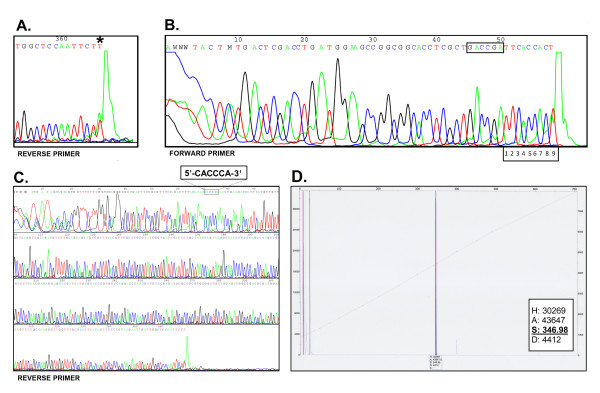Figure 6.
Determination of TaqII REase recognition sequence and cleavage site. Cleavage reactions of PCR(sequencing) and PCR(GeneScan) DNA substrates were performed as described in Materials and Methods. (A) This panel is the enlargement of the sequence end shown in Figure 6C. DNA sequencing of a 401 bp TaqII cleavage reaction product using reverse primer, annealing to the top strand, as arbitrarily set for the strand containing 5'-GACCGA-3' cleavable TaqII site (Figure 1D). The appropriate DNA fragment was isolated from an agarose gel following gel electrophoresis. The asterisk denotes the cleavage point at position 98 of the substrate DNA fragment (Figure 1D). (B) DNA sequencing of a 95 bp TaqII cleavage reaction product using forward primer, annealing to the bottom strand, as arbitrarily set for the strand containing 5'-GACCGA-3' cleavable TaqII site (Figure 1D). Thus the polymerization reaction goes through 5'-GACCGA-3' and stops at the end of the bottom strand template due to the cleavage distance of 9 nt. The appropriate DNA fragment was isolated from an agarose gel following gel electrophoresis. (C) DNA sequencing of non-purified TaqII cleavage reaction products using reverse primer, annealing to the top strand, as arbitrarily set for the strand containing 5'-GACCGA-3' cleavable TaqII site (Figure 1D). The sequencing reaction ends at the TaqII cleavage point at the 98 position of the substrate PCR(sequencing) DNA fragment (Figure 1D). (D) GeneScan gel analysis of TaqII cleavage. TaqII-cleaved 5'-labelled 402 bp PCR was gel purified and capillary electrophoreses in the presence of labelled DNA length markers. The TaqII cleavage product length reading of 347 nt (assuming standard +/- 1 nt error of the GeneScan) indicates 11/9 cleavage points after the 5'-GACCGA-3' site.

